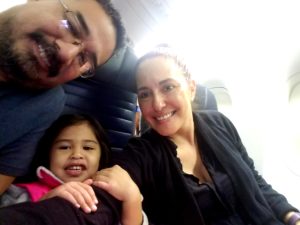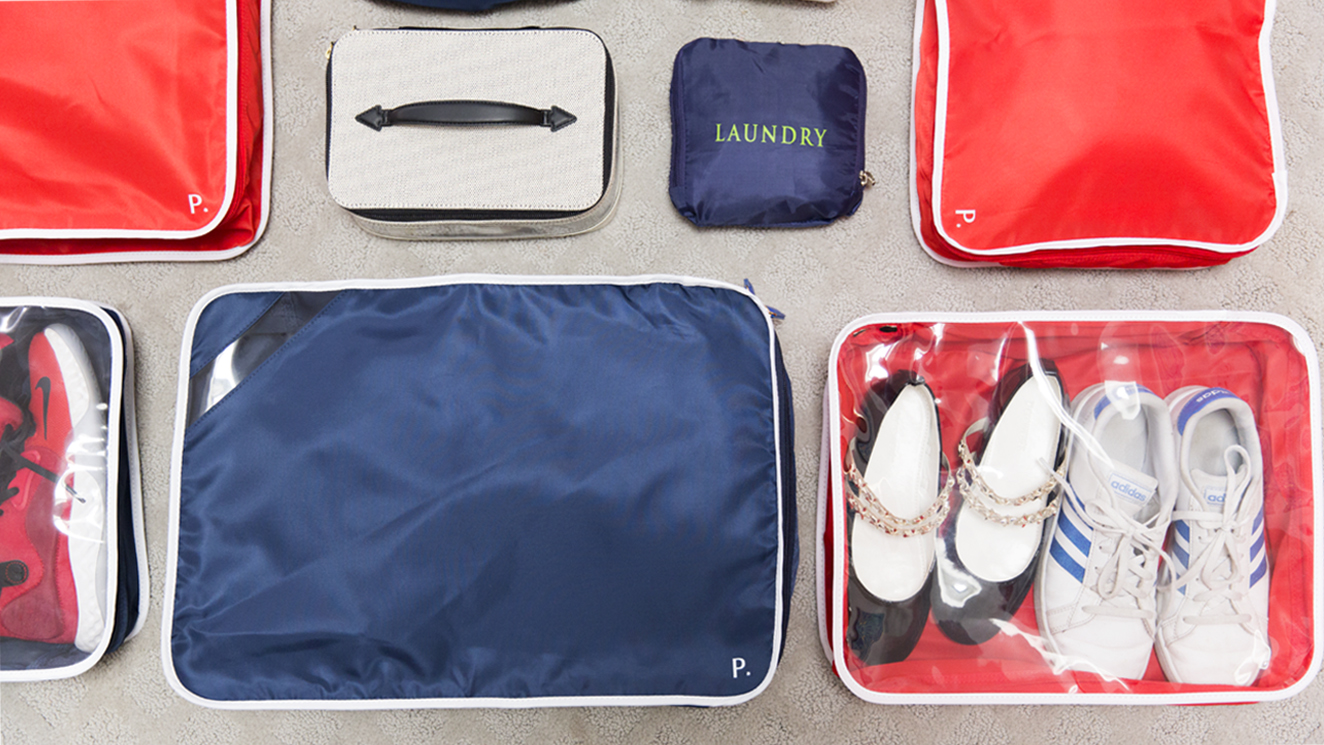

I was a flight attendant for years, and I see it day in and day out – the look of sheer panic and helplessness on parents’ faces when they board a plane with their children. I’m also a mom, so I notice these things! But I always tell people that when it comes to flying with kids, you have more control then you realize! I live in Los Angeles, but my husband and I are originally from Hawaii. My daughter is now eight and has made that round trip (five-and-a half hours) five times without tears or tantrums, which I attribute both to dumb luck and to my insider tricks of the trade. So let me share some of my survival tips, in case it can help anyone. Keep in mind that a few of these suggestions may not be in line with the mom you are at home, but remember: you are not at home. You are in a tube at 37,000 feet trying to survive the next few hours. Here’s some of my advice for flying with kids.
BOOKING
- Check in. Many people think that when they book their seats, they are set. This is NOT TRUE. Until you actually check in for those seats, they can be reassigned. So set your alarm (generally 24 hours prior) and check in to secure your seats as soon as you’re allowed to do so.
- Morning flights. I always advise flying in the morning because the probability of delays is significantly lower. In the airline industry, on-time stats are impacted as the day progresses. Whether it’s aircraft availability, weather, or crew-scheduling, these problems become more likely later in the day. Also, arriving at your destination at an earlier time has its own benefits as you know if you have ever tried to retrieve your rental car late at night, or tried to squeeze your way onto a shuttle bus that’s jam-packed with all the other delayed travelers. The lines are around the block and the kids are fussy and exhausted from travel. The moral of the story is bite the bullet, set your alarm and get on the road. It’s worth it.
- Red-eye flights. This one is tricky. Red-eye flights have their advantages but they can be a double-edged sword. Many parents think the red-eye is a great way to get their kids to sleep the whole flight. This can work well, especially for older kids. (It happens to work for my child and we always take the red-eye back from Hawaii.) But for some parents, particularly those with babies between one and two, this can backfire. I’m not saying this happens to everyone, but young kids get overstimulated and don’t sleep, and then it’s a loooong flight.

AIRPLANE 411 (AKA LOCATION, LOCATION, LOCATION)
We all know that where you sit has a huge impact on your flying experience, but not all of us can spring for first class tickets! Here are a few things to consider when booking your seat. Keep in mind much of this depends on aircraft type.
- “Economy Plus” is worth it. For many airlines, the first few rows of the main cabin have extra leg room, and those seats come at a price. However, there’s more to gain than extra legroom when you purchase these seats. For one thing, you are able to board and deplane before the main flow of traffic. Also, the flight crew serves from front to back and will run out of choices during the course of the service. The closer you are to the front, the more likely you are to get your choice of meal, snack or drink.
- Avoid the back row. The seats typically don’t recline. It’s a high traffic area. The main cabin galley is in the back of the cabin and the flight attendants move through here with heavy carts and equipment. If you have children who want to move about, this isn’t a good location. Additionally, the bathrooms are usually located in the back of the cabin, again this depends on aircraft type. Not to be crude, but if you don’t want to smell poo periodically throughout the flight, don’t sit here.
- Confirm your moveable armrests. Most rows have movable armrests, which is great for your kids spreading out or sleeping. This information isn’t always available as you book your seat, but the airline may provide it for you on request.

courtesy Jennifer Lee Loy
FOOD
You never know what an airline is serving or if they are serving anything at all. Do not put this basic essential in their hands. Shop or prepare food the day before, remembering to avoid any liquids – which also means no puddings, fruit cups, yogurt, puree pouches, etc. All can be swiped by TSA. For babies I recommend powdered formula, you can easily request water to add and shake up in a bottle. Milk is another challenge. Many airlines don’t provide the flights with much milk. The supply they give us is primarily for coffee drinkers. If milk is a must, buy a carton in the airport before you board.
- Sandwiches and wraps FTW. They don’t take up much space nor do they require a container or utensils that could be pulled by TSA. I place all the meals in an old takeout bag or grocery bag. When you’re done eating, you collect your family’s trash in this plastic bag and hand it to the flight attendant for disposal. Voila! Look at all the space that just freed up in your bag! When I don’t have time to prepare food the day before, I like to go to Trader Joe’s or Subway. Whether your sandwiches are made or bought, just make sure that you don’t add condiments or dressing the day before.
- Repackage snacks. Snacks are a must, but again, always think about maximizing your storage space. If you buy prepackaged chips or cookies, the puffy, air-filled packages can take up space. Transfer them to reusable bags or ziplocks. I’m a big fan of Stashers. They’re slim and fit nicely into your rollaway or purse after use.
- Hydrate like you mean it. Drinks are tricky, but don’t let the TSA stand between you and hydration! Two options: 1) Carry an empty water bottle through security and fill it at a water station near your gate. 2) Buy an extra drink in the airport before your flight (after security, of course). It is pricey but not an unwise investment.
- Maximize your kid’s bag. Every traveler gets a carry-on, including your child. I see parents buy cute rollaways for their kids so they can feel like grown up travelers, yet the bag has nothing in it! Use their bag space, especially if you have multiple kids. This way they all have their own snacks and supplies.

DIGITAL (AND ANALOG!) ENTERTAINMENT
Devices may be your demon at home, but they’re your savior on an aircraft! Not only are your kids entertained for hours on end, but prepping this can be checked off your travel to-do list days in advance.
- Downloads. You can do this days before you begin the tumultuous task of actually packing everyone. Collect some new episodes along with a few old favorites.
- Timing. I don’t turn on the devices until we are well in the air and the flight attendants have come by with their first service, for a few reasons. For one thing, the devices are your trump card, you don’t want to use them too early, nor do you want your kid’s head buried in them the whole time. Secondly, the early phases of flight are what we call critical phases. There’s important information shared, like the safety demonstration and announcements. Your kids may be young but you are training them about the importance of these things later in life. And why do I tell parents to wait until after the service cart? Because if everyone has headphones on, it’s difficult to communicate what you want to your flight attendants or hear what they’re offering you.
- Earphones. And on that note, your fellow passengers don’t want to hear The Mickey Mouse Clubhouse song for hours on end. Bringing headphones may seem obvious but you have no idea how many people don’t bring headphones for their kids and then the cabin crew is breaking up a fight. Let your child help pick out a cool pair of noise-reducing headphones that they can look forward to using inflight.
- A new toy, activity or book. The movies and games may hold them for awhile, but eventually they may get antsy again. I pull out the brand new toy or activity out in the middle of the flight. It gives their eyes a break from the devices and the surprise (don’t let them know you have it until that moment) will engage them again.
- Reading. My daughter is of solo-reading age now. Reading is something she is required to do at home, why not on the plane? (And who says that time spent reading on a plane can’t “count” on their school reading log?) I have her read during the boarding process and mid-flight – though note that reading during takeoff and landing can cause motion sickness. I’m a fan of toting along National Geographic for Kids. It’s a thin magazine that’s educational and includes activities. Highlights is another oldie but goodie.
When I am asked for travel advice, I will always steer in the direction of empowerment. When it comes to air travel, not everything is in our control, but there’s so much you can do to create a more enjoyable experience for your kids and yourself. If you own your flying experience as much as possible, you are training the next generation to own theirs.







